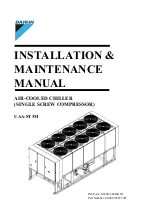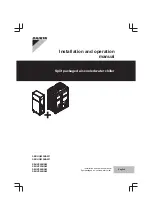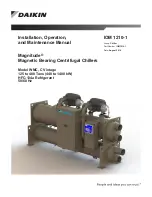
QUANTECH
91
FORM QTC4-NM1
ISSUE DATE: 4/2/2018
6
SECTION 6 - COMMISSIONING
PREPARATION
Commissioning of this unit should only
be carried out by Quantech Authorized
personnel.
Commissioning personnel should be thoroughly
familiar with the information contained in this docu-
ment before starting the unit.
The following basic checks should be made with the
customer power to the unit switched OFF.
Proper electrical lock out and tag out
procedures must be followed.
Inspection
Inspect unit for installation damage. If found, take
action and/or repair as appropriate.
Refrigerant Charge
Packaged units are normally shipped as standard with
a full refrigerant operating charge. Check that refrig-
erant pressure is present in both systems and that no
leaks are apparent. If no pressure is present, a leak test
must be undertaken, the leak(s) located and repaired.
Do not evacuate or liquid charge with static water in
the evaporator. Turn the pump on. Take care to liq-
uid charge slowly to avoid excessive thermal stress
at the charging point and to assure the refrigerant
temperature in the evaporator does not go below the
freezing point with liquid refrigerant in the evapo-
rator. Once the vacuum is broken, charge into the
evaporator or flash tank with the Condenser Drain
Valve (Flash Tank Feed) open and the chilled liquid
pump ON to the full operating charge, as detailed in
.
Correct System Refrigerant Charge
The charge on a system should always be checked
when operating for several minutes at full speed with
the system stable. Stable conditions are defined as
operation without fan cycling, economizer cycling, VI
solenoid cycling, or any other system transient condi-
tions. Ideal refrigerant charge will be reached when the
refrigerant level in the evaporator is near the middle of
the evaporator sight glass.
Refrigerant should not be added or
removed unless the level is at the bottom
or the top of the glass. It is not necessary to
weigh charge unless the entire charge has
been lost. The ease of charging is possible
since the microchannel coils hold only a
small amount of refrigerant charge. A
charging valve is located between the fixed
orifice and the evaporator for adjusting
charge. Charge should be added as liquid
with the pump ON and liquid flowing
through the evaporator.
Service and Oil Line Valves
Open each compressor oil, economizer, and discharge
ball or service valves. If valves are of the back-seat
type, open them fully (counterclockwise) then close
one turn of the stem to ensure operating pressure is fed
to pressure transducers.
Compressor Oil
To add oil to a circuit - connect a hand oil pump
(Part No. 470-10654-000) to the 1/4" (6.35 mm) oil
charging valve on the oil separator piping with a length
of clean hose or copper line, but do not tighten the flare
nut. Using clean oil of the correct type (“L” oil), pump
oil until all air has been purged from the hose then
tighten the nut. Stroke the oil pump to add oil to the oil
system. While the compressor is running at full speed,
the oil level should be visible in the sight glass of the
oil separator. Approximately 2 to 3.1 gallons (7.5 to
11.6 liters) are present in each refrigerant system.
Summary of Contents for QTC4 STYLE A Series
Page 22: ...QUANTECH 22 FORM QTC4 NM1 ISSUE DATE 03 07 2018 THIS PAGE INTENTIONALLY LEFT BLANK...
Page 34: ...QUANTECH 34 FORM QTC4 NM1 ISSUE DATE 03 07 2018 THIS PAGE INTENTIONALLY LEFT BLANK...
Page 56: ...QUANTECH 56 FORM QTC4 NM1 ISSUE DATE 03 07 2018 THIS PAGE INTENTIONALLY LEFT BLANK...
Page 90: ...QUANTECH 90 FORM QTC4 NM1 ISSUE DATE 03 07 2018 THIS PAGE INTENTIONALLY LEFT BLANK...
Page 148: ...QUANTECH 148 FORM QTC4 NM1 ISSUE DATE 03 07 2018 THIS PAGE INTENTIONALLY LEFT BLANK...
Page 160: ...QUANTECH 160 FORM QTC4 NM1 ISSUE DATE 03 07 2018 THIS PAGE INTENTIONALLY LEFT BLANK...
Page 163: ...QUANTECH 163 FORM QTC4 NM1 ISSUE DATE 4 2 2018 NOTES...
















































